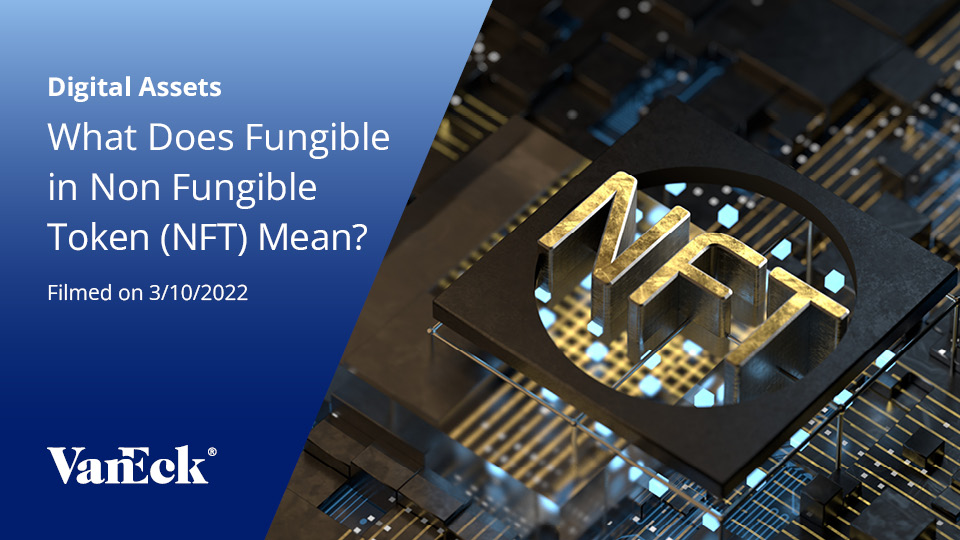No Jargon Blockchain Cheat Sheet
February 04, 2022
Read Time 6 MIN
Please note that VanEck may have a position(s) in the digital asset(s) described below.
We at VanEck are always working to broaden and develop our understanding of the digital asset space. As a sales manager at VanEck, I felt it important to equip my team with an understanding of blockchain and crypto to allow us to better address the topics with clients, as the digital assets space continues to develop.
For these reasons, I constructed the cheat sheet below to help provide context for crypto concepts. This cheat sheet is intended to define and explain the fundamental elements of blockchain to aid in crypto learning.
Explaining Blockchain Technology:
One helpful analogy I have found compared the blockchain to glass deposit boxes in a bank vault. A bank vault contains rows of deposit boxes. Each deposit box is made of glass, allowing people to easily view the contents of the box, although they do not have access to the box’s contents.
An individual opening a deposit box will receive a key specific to that box. They do not own the box, although they now have access to the box’s contents.
Similar to this series of glass boxes, a blockchain contains content others can see and verify, but cannot change. When a crypto wallet (glass deposit box) is opened, a new address is created within the blockchain and only the private key (created when the individual opens their crypto wallet) “unlocks” this address.1
Explaining Bitcoin Mining Calculations
Proof of Work
Mining is the creation of new blocks in the Bitcoin blockchain. Two of the main purposes for mining are:
- To validate transactions to the blockchain.
- To distribute the 21 million bitcoin supply to miners who work to secure the network by awarding them with new coins.2
A helpful example may be to imagine that miners in the Bitcoin network are gamblers at a casino with each gambler having a 1,000-sided dice. The goal is to roll a number less than 10. For an individual, this may take a very long time, but with more gamblers, rolling a number less than 10 becomes easier. The more gamblers join, the quicker it is to meet this goal.
When a number less than 10 is rolled, the number will be verified by the gamblers at the table. The prize money is awarded to the lucky roller, and they move onto the next round.
Mining bitcoin is a similar process. Miners will use Application Specific Integrated Circuits (ASICs), computers that are specifically designed to compute hashes as quickly as possible. Computing a hash involves entering random inputs into mathematical functions to produce an output.
A higher hash rate, which is more hashes per second, is comparable to more dice rolls per second in our gambling example, increasing the probability of success.3
For additional examples, we found a helpful breakdown in this article: Cryptographic Puzzle – Understanding Proof of Work.4
Proof of Stake Compared to Proof of Work
Instead of using proof of work (the energy used to perform complex calculations), proof of stake can be used as a way to incentivize good validator behavior. Certain actions can result in a user losing a portion of or even their entire stake, like going offline (failing to validate) or deliberate collusion. The assumption is that a miner should be less likely to attack a network if they have a stake in the game under this model.
Crypto Terms to Know
There are certain words and phrases to know when discussing crypto. We have provided some key terms here as a basis. For additional terms, we find it helpful to refer to this glossary.5
- Blockchain - A transparent ledger system consisting of a series of blocks containing verified transactions. Entries are immutable, meaning they cannot be erased once placed on this distributed ledger.
- Distributed Ledger - A system of recording information that is spread across several different devices. The blockchain is a distributed ledger that was created to keep track of all bitcoin transactions.
- Halving - It is a process of cutting the rewards of mining Bitcoin in half after around 210,000 blocks are mined, typically around every four years. Halving is used to limit supply and ensure that the number of Bitcoin in circulation does not increase exponentially. A highly anticipated event for Bitcoin.
- Hash Rate - The measure of computing and processing power used in crypto mining. A higher hash rate indicates a stronger network.
- Private Key - Similar to a private password, a string of random letters and numbers, which allows access to and management of your crypto funds.
Blockchain Disruption Examples of the Past, Present, and Future
Different milestones in the blockchain timeline have disrupted traditional finance and Web 2.0, or the centralized web that we currently use.6 We provide a quick look at past, present and potential future disruptors.
Past: Listing of Coinbase
As an exchange, Coinbase’s primary competitors are ICE/NYSE and Nasdaq. Coinbase listed at 2x Nasdaq valuations, and nearly the same as ICE/NYSE. Who would have thought a digital asset exchange would be worth twice what Nasdaq is worth?
Present: NFTs and Gaming
Non-fungible tokens (NFTs) are disrupting how people think about digital ownership of items. As the metaverse continues to evolve, ownership of digital items based on blockchain technology will continue to create inroads into the video gaming world. We expect the development of an EA/Activision blockchain so that users can buy/sell their items to other gamers and participate economically in the success of a game.
Future: FAANG/Consumer Tech Disruption
Toll collectors are a problem that consumers face in Web 2.0. Airbnb charges a toll for users to meet and exchange goods (i.e., 20% fee for listing your house on Airbnb). As the blockchain/decentralized application network grows, and as the user interface/ease-of-use problems are solved, there will likely be a “blockchain” version of most of these toll collectors, which provides cheaper, more efficient solutions to the same problem. We believe there will come a day when the choice is “Airbnb” or “Blockchain Airbnb,” and the blockchain version may be 10-15% cheaper to use. At that point, we will likely see widespread proliferation of decentralized applications and disruption in several of these “toll collector” situations. Other toll collector examples include Spotify, Uber, Apple Store, and Amazon.
Crypto in Context
We have given quick descriptions of several cryptocurrencies to provide context and clarify their differences. For more coin descriptions, we recommend looking at 100 Cryptocurrencies Described in Four Words or Less.7
- Bitcoin (BTC): Many view Bitcoin as comparable to gold and consider it a store of value.
- Ethereum (ETH): Ethereum provides technology for smart contract capability.
- Ripple (XRP): Ripple is a real-time settlement network.
- Cardano (ADA): Cardano is an open-source, decentralized blockchain platform that can facilitate transactions and smart contracts.
- Dogecoin (DOGE): Also referred to as a “meme coin,” Dogecoin is a cryptocurrency that was created satirically to highlight the speculation in cryptocurrencies.
The blockchain and crypto space is always evolving. It is important to understand these fundamental concepts as the space develops.
For further learning, we have created a helpful Crypto Guide to aid in navigating our crypto and digital assets resources.
Access our crypto and digital assets education and research for more insights to the digital assets space.
To receive more Digital Assets insights, sign up in our subscription center.
Related Topics
Related Insights
DISCLOSURES
1 Explaining blockchain - https://www.transformationworx.com/post/2018/06/07/3-analogies-that-explain-how-blockchain-technology-works
2 Explaining mining calculations: - https://braiins.com/blog/bitcoin-mining-analogy-beginners-guide
3 Explaining mining calculations: - https://braiins.com/blog/bitcoin-mining-analogy-beginners-guide
4 Cryptographic - Proof of work - https://www.mangoresearch.co/cryptographic-puzzle-proof-of-work
5 Glossary of terms: - https://www.morningstar.com/articles/1050329/a-basic-glossary-of-terms-for-crypto-newbies
6 Investopedia: Web 2.0: current state of the internet, which has more user-generated content and usability for end-users compared to Web 1.0. Web 2.0 refers to a shift in how the Internet is used. In the new age of the Internet, there is a higher level of information sharing and interconnectedness among participants.
7 Crypto in 4 words or less - https://techcrunch.com/2017/11/19/100-cryptocurrencies-described-in-4-words-or-less
Please note that VanEck may offer investments products that invest in the asset class(es) or industries included herein.
This is not an offer to buy or sell, or a recommendation to buy or sell any of the cryptocurrencies mentioned herein. The information herein represents the opinion of the author(s), but not necessarily those of VanEck, and these opinions may change at any time. Non-VanEck proprietary information contained herein has been obtained from sources believed to be reliable, but not guaranteed. Not intended to be a forecast of future events, a guarantee of future results or investment advice. Historical performance is not indicative of future results. Current data may differ from data quoted. Any graphs shown herein are for illustrative purposes only.
Cryptocurrency is a digital representation of value that functions as a medium of exchange, a unit of account, or a store of value, but it does not have legal tender status. Cryptocurrencies are sometimes exchanged for U.S. dollars or other currencies around the world, but they are not generally backed or supported by any government or central bank. Their value is completely derived by market forces of supply and demand, and they are more volatile than traditional currencies. The value of cryptocurrency may be derived from the continued willingness of market participants to exchange fiat currency for cryptocurrency, which may result in the potential for permanent and total loss of value of a particular cryptocurrency should the market for that cryptocurrency disappear. Cryptocurrencies are not covered by either FDIC or SIPC insurance. Legislative and regulatory changes or actions at the state, federal, or international level may adversely affect the use, transfer, exchange, and value of cryptocurrency.
Investing in cryptocurrencies comes with a number of risks, including volatile market price swings or flash crashes, market manipulation, and cybersecurity risks. In addition, cryptocurrency markets and exchanges are not regulated with the same controls or customer protections available in equity, option, futures, or foreign exchange investing. There is no assurance that a person who accepts a cryptocurrency as payment today will continue to do so in the future.
Investors should conduct extensive research into the legitimacy of each individual cryptocurrency, including its platform, before investing. The features, functions, characteristics, operation, use and other properties of the specific cryptocurrency may be complex, technical, or difficult to understand or evaluate. The cryptocurrency may be vulnerable to attacks on the security, integrity or operation, including attacks using computing power sufficient to overwhelm the normal operation of the cryptocurrency’s blockchain or other underlying technology. Some cryptocurrency transactions will be deemed to be made when recorded on a public ledger, which is not necessarily the date or time that a transaction may have been initiated.
- Investors must have the financial ability, sophistication and willingness to bear the risks of an investment and a potential total loss of their entire investment in cryptocurrency.
- An investment in cryptocurrency is not suitable or desirable for all investors.
- Cryptocurrency has limited operating history or performance.
- Fees and expenses associated with a cryptocurrency investment may be substantial.
There may be risks posed by the lack of regulation for cryptocurrencies and any future regulatory developments could affect the viability and expansion of the use of cryptocurrencies. Investors should conduct extensive research before investing in cryptocurrencies.
Information provided by Van Eck is not intended to be, nor should it be construed as financial, tax or legal advice. It is not a recommendation to buy or sell an interest in cryptocurrencies.
All investing is subject to risk, including the possible loss of the money you invest. As with any investment strategy, there is no guarantee that investment objectives will be met and investors may lose money. Diversification does not ensure a profit or protect against a loss in a declining market. Past performance is no guarantee of future results.
Van Eck Associates Corporation
Related Insights
April 08, 2022
Related Funds
DISCLOSURES
1 Explaining blockchain - https://www.transformationworx.com/post/2018/06/07/3-analogies-that-explain-how-blockchain-technology-works
2 Explaining mining calculations: - https://braiins.com/blog/bitcoin-mining-analogy-beginners-guide
3 Explaining mining calculations: - https://braiins.com/blog/bitcoin-mining-analogy-beginners-guide
4 Cryptographic - Proof of work - https://www.mangoresearch.co/cryptographic-puzzle-proof-of-work
5 Glossary of terms: - https://www.morningstar.com/articles/1050329/a-basic-glossary-of-terms-for-crypto-newbies
6 Investopedia: Web 2.0: current state of the internet, which has more user-generated content and usability for end-users compared to Web 1.0. Web 2.0 refers to a shift in how the Internet is used. In the new age of the Internet, there is a higher level of information sharing and interconnectedness among participants.
7 Crypto in 4 words or less - https://techcrunch.com/2017/11/19/100-cryptocurrencies-described-in-4-words-or-less
Please note that VanEck may offer investments products that invest in the asset class(es) or industries included herein.
This is not an offer to buy or sell, or a recommendation to buy or sell any of the cryptocurrencies mentioned herein. The information herein represents the opinion of the author(s), but not necessarily those of VanEck, and these opinions may change at any time. Non-VanEck proprietary information contained herein has been obtained from sources believed to be reliable, but not guaranteed. Not intended to be a forecast of future events, a guarantee of future results or investment advice. Historical performance is not indicative of future results. Current data may differ from data quoted. Any graphs shown herein are for illustrative purposes only.
Cryptocurrency is a digital representation of value that functions as a medium of exchange, a unit of account, or a store of value, but it does not have legal tender status. Cryptocurrencies are sometimes exchanged for U.S. dollars or other currencies around the world, but they are not generally backed or supported by any government or central bank. Their value is completely derived by market forces of supply and demand, and they are more volatile than traditional currencies. The value of cryptocurrency may be derived from the continued willingness of market participants to exchange fiat currency for cryptocurrency, which may result in the potential for permanent and total loss of value of a particular cryptocurrency should the market for that cryptocurrency disappear. Cryptocurrencies are not covered by either FDIC or SIPC insurance. Legislative and regulatory changes or actions at the state, federal, or international level may adversely affect the use, transfer, exchange, and value of cryptocurrency.
Investing in cryptocurrencies comes with a number of risks, including volatile market price swings or flash crashes, market manipulation, and cybersecurity risks. In addition, cryptocurrency markets and exchanges are not regulated with the same controls or customer protections available in equity, option, futures, or foreign exchange investing. There is no assurance that a person who accepts a cryptocurrency as payment today will continue to do so in the future.
Investors should conduct extensive research into the legitimacy of each individual cryptocurrency, including its platform, before investing. The features, functions, characteristics, operation, use and other properties of the specific cryptocurrency may be complex, technical, or difficult to understand or evaluate. The cryptocurrency may be vulnerable to attacks on the security, integrity or operation, including attacks using computing power sufficient to overwhelm the normal operation of the cryptocurrency’s blockchain or other underlying technology. Some cryptocurrency transactions will be deemed to be made when recorded on a public ledger, which is not necessarily the date or time that a transaction may have been initiated.
- Investors must have the financial ability, sophistication and willingness to bear the risks of an investment and a potential total loss of their entire investment in cryptocurrency.
- An investment in cryptocurrency is not suitable or desirable for all investors.
- Cryptocurrency has limited operating history or performance.
- Fees and expenses associated with a cryptocurrency investment may be substantial.
There may be risks posed by the lack of regulation for cryptocurrencies and any future regulatory developments could affect the viability and expansion of the use of cryptocurrencies. Investors should conduct extensive research before investing in cryptocurrencies.
Information provided by Van Eck is not intended to be, nor should it be construed as financial, tax or legal advice. It is not a recommendation to buy or sell an interest in cryptocurrencies.
All investing is subject to risk, including the possible loss of the money you invest. As with any investment strategy, there is no guarantee that investment objectives will be met and investors may lose money. Diversification does not ensure a profit or protect against a loss in a declining market. Past performance is no guarantee of future results.
Van Eck Associates Corporation
Related Insights
April 08, 2022








